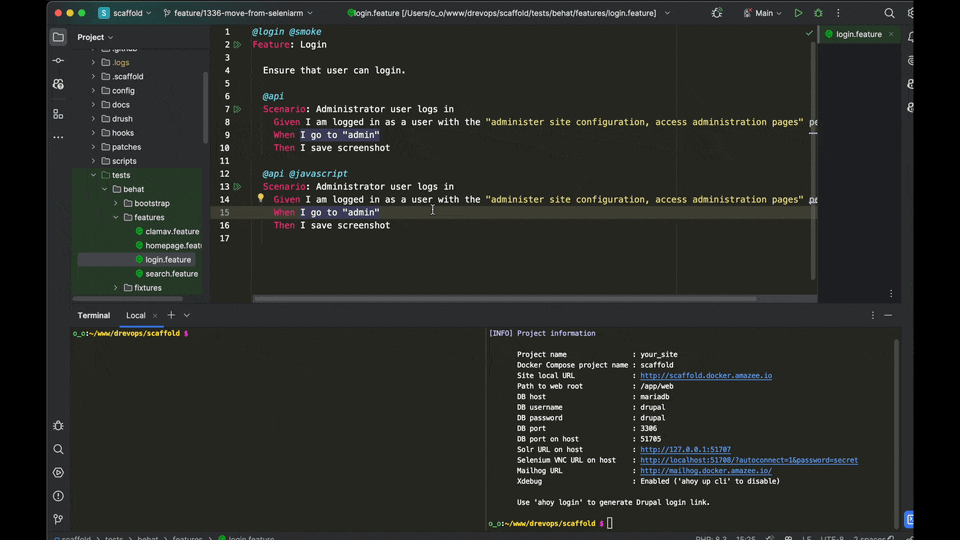Behat
https://github.com/Behat/Behat
https://docs.behat.org/en/latest/user_guide.html
A php framework for auto-testing your business expectations.
Vortex comes with pre-configured Behat profiles for Drupal projects.
Usage
Since Behat requires a running Drupal instance, it can only be run within container environment.
- Ahoy
- Docker Compose
ahoy test-bdd
docker compose exec cli php -d memory_limit=-1 vendor/bin/behat
Running all tests in the file
- Ahoy
- Docker Compose
ahoy test-bdd tests/behat/features/my.feature
docker compose exec cli vendor/bin/behat tests/behat/features/my.feature
Running tagged tests with @group_name tag
- Ahoy
- Docker Compose
ahoy test-bdd --tags=group_name
docker compose exec cli vendor/bin/behat --tags=group_name
Configuration
All global configuration takes place in the behat.yml file.
By default, Behat will run all tests defined in tests/behat/features directory.
Adding or removing test targets:
default:
suites:
default:
paths:
- '%paths.base%/web/modules/custom/mymodule/tests/behat/features'
Contexts and extensions
The configuration uses the following contexts and extensions:
- Drupal Extension: The Drupal Extension is an integration layer between Behat, Mink Extension, and Drupal. It provides step definitions for common testing scenarios specific to Drupal sites.
- Behat Screenshot Extension: Behat extension and step definitions to create HTML and image screenshots on demand or when tests fail.
- Behat Progress Fail Output Extension: Behat output formatter to show progress as TAP and fails inline.
- Behat Steps: Collection of Behat steps for Drupal
Reports and screenshots
Behat is configured to generate test run reports in JUnit format stored in
.logs/test_results/behat.
Screenshots for failed tests or purposely made screenshots are stored in
.logs/screenshots directory.
Both test results and screenshots are stored as artifacts when run in continuous integration pipelines.
Profiles
Behat runs with default profile defined in the configuration file: this runs
all tests not tagged with @skipped tag.
There are also p1 and p2 profiles defined that run tests not tagged with
@skipped and tagged with @p1 and @p2 tags respectively. These profiles are
used in continuous integration pipeline to run tests in parallel if parallel
runners number is greater than 1.
Behat will run tests using @pX tags on tests, where X is the runner index
starting from 0.
In the example below, if there is one runner, Behat will run all scenarios, but
if there are 2 runners - Behat will run only scenarios with @p0 tag on the
first runner and scenarios with @p1 tag on the second runner.
@homepage @smoke
Feature: Homepage
Ensure that homepage is displayed as expected.
@api @p0
Scenario: Anonymous user visits homepage
Given I go to the homepage
And I should be in the "<front>" path
Then I save screenshot
@api @javascript @p1
Scenario: Anonymous user visits homepage
Given I go to the homepage
And I should be in the "<front>" path
Then I save screenshot
The profile can be overridden using $VORTEX_CI_BEHAT_PROFILE environment
variable set in the continuous integration pipeline configuration.
Writing tests
When writing tests, it is recommended to use the following structure:
@tag_describing_feature_group
Feature: Short feature description
As a site owner
I want to make sure that my feature does what it is supposed to do
So that I can be sure that my site is working as expected
@api
Scenario: Anonymous user uses a feature
Given I go to the homepage
And I should be in the "<front>" path
Then I save screenshot
@api @javascript
Scenario: Anonymous user uses a feature with AJAX
Given I go to the homepage
And I click ".button" element
Then I save screenshot
Use @api tag for tests that do not require JavaScript and @api @javascript
for tests that require JavaScript.
JavaScript tests are slow. Try using as few JavaScript tests as possible to keep the test run time low.
FeatureContext.php
The FeatureContext.php
file is a Behat custom context file that is loaded by default. This is where
custom step definitions and hooks should be placed.
It is recommended to use traits to organize step definitions and hooks and
include those traits in the FeatureContext.php file. There are already
several traits included from the Behat Steps
package.
There are also example tests in the tests/behat/features
directory that can be used as a starting point for writing tests. These tests
define @smoke tests for the homepage and login page as well as tests for
contributed modules.
Connecting to the browser
For @javascript tests, Behat uses Selenium to connect to the browser. The
browser runs within a container and can be observed from the host machine by
using a browser thanks to the VNC server running in the container and noVNC.
- Ahoy
- Docker Compose
- Get the link for Selenium VNC URL on host:
ahoy info
- Click on the link next to
Selenium VNC URL on hostto open the browser.
- Get the port number:
docker compose port chrome 7900
- Replace
<port>with the value above and openhttp://localhost:<port>/?autoconnect=1&password=secretin your browser.
When running tests, you can add And I wait for 60 seconds step to suspend
the test execution for a minute and interact with the headless browser in a
container through a browser on your host machine.

Ignoring fail in continuous integration pipeline
This tool runs in continuous integration pipeline by default and fails the build if there are any violations.
Set VORTEX_CI_BEHAT_IGNORE_FAILURE environment variable to 1 to ignore
failures. The tool will still run and report violations, if any.
Due to the size of your website and the available continuous integration runner resources, Behat tests may occasionally fail.
To prevent the pipeline from failing as a result, any failed Behat test will be retried automatically.